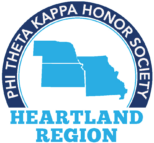At a meeting of the presidents of the Missouri junior colleges for women in 1918, it was decided to organize a new honorary society, chapters of which would have a common character, stand and similarity of organization.
The name Phi Theta Kappa was chosen, and the Society was incorporated in Missouri as a national organization. Founders modeled many aspects of the new Society after the prestigious senior college honorary society, Phi Beta Kappa.
The eight charter colleges of Phi Theta Kappa were Hardin, Stephens, Christian, Lindenwood, Cottey, Howard Payne, William Woods and Central. The Alpha Chapter was established at Hardin College but was later moved to Stephens College when Hardin College became a baccalaureate granting institution. Today, Cottey College in Nevada, Missouri, is the only charter college with an active Phi Theta Kappa chapter.
For the first six years, Phi Theta Kappa confined its activity to women's junior colleges, but in 1924 through constitutional amendment, the field of activity was enlarged to cover all junior colleges.
In 1930, Margaret James (Mosal) became the first elected national president of Phi Theta Kappa while attending Whitworth College in Brookhaven, Mississippi. She became national secretary in 1935 and moved the records of the organization to her hometown of Canton. Mosal served as Phi Theta Kappa's chief executive for 50 years, retiring as Executive Director in 1985.
In the early years, Phi Theta Kappa membership was conferred to students at time of graduation and few programs and services were offered. The explosive growth of community colleges in the 1960s led Phi Theta Kappa to expand its mission to reflect the nurturing philosophy of the institutions it served. Students were inducted as freshmen and study programs were offered.
